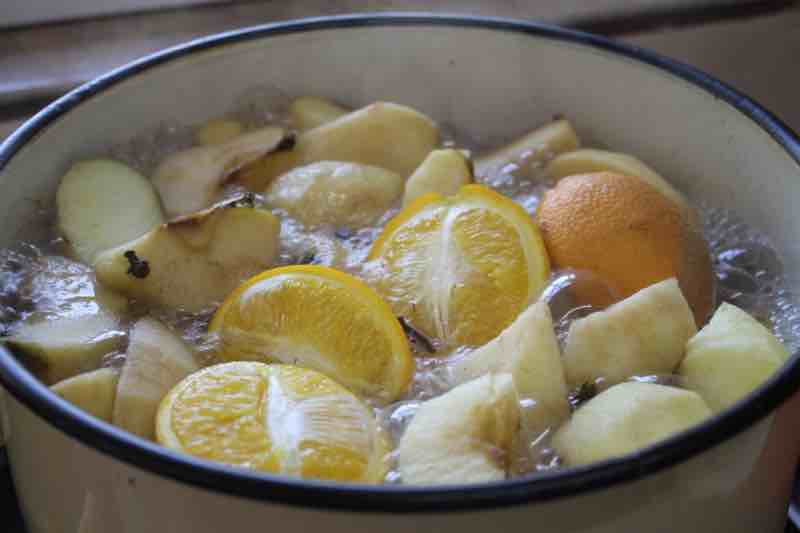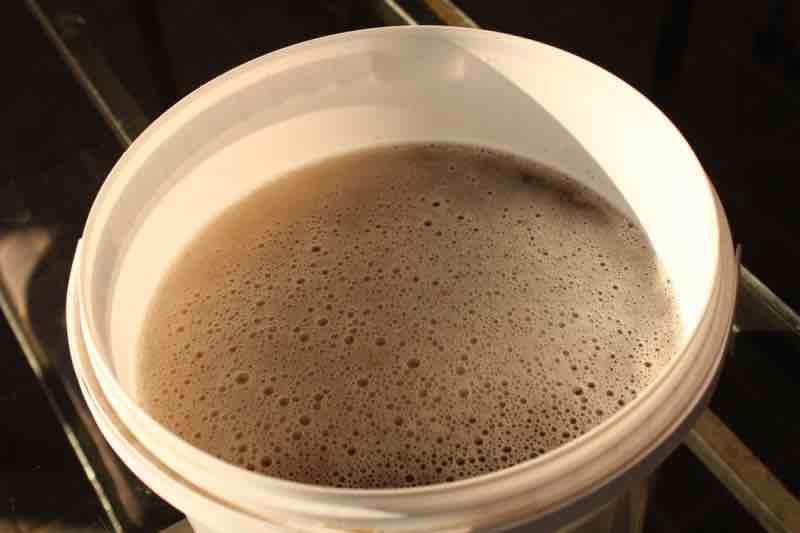- Bernard Preston homepage
- Our green kitchen
- How Is Apple Cider Made
How is apple cider made?
How is apple cider made is a question you will probably only ask if you have several trees in the garden, access to surplus-fruit or perhaps know a greengrocer who is turfing out a box that has seen better days.
You need 3 or 4 apples per litre of cider. The kick will be determined by how long you decide to let it ferment. A hydrometer will give you an accurate measure of the alcohol-content; only if you really want to know.
Today we are making a light-brew for a hot summer's day; not one that will be the ruin of your character and give you a headache for a week.

Ingredients for 4 litres of apple cider
Start by making certain you have a couple trays of ice in the freezer; and a few wine bottles of cold-water in the fridge. Cooling the hot wort as quickly as possible is very important.
- 12 - 20 apples, washed and quartered
- 2 oranges, washed and halved
- 3 litres of cold water
- 1 litre of ice-cubes
- A chunk of freshly-peeled ginger
- 1 tsp cloves
- A couple chunks of cinnamon
- 3 TBSP of raw-honey
You will need a packet of dried-yeast later.
Using a pressure-cooker
- Boil the fruit, spices and one litre of water in a pressure-cooker for 20 minutes.
- Place the pressure-cooker in a bucket of cold water; under a running tap.
- Using a potato-masher, squish the fruit.
- Cool and then strain through muslin into a 5 litre plastic-bucket; use the cold water to extract more juice from the pulp.
- Add 1 to 3 tablespoons of raw-honey, depending on how strong you want your cider to be.
- Add the ice and quickly get the temperature down to around 20-degrees Celsius.
- Make up to about 4 litres.
- Add 1/4 tsp of dried-yeast; hydrate it first for twenty minutes.
- Bottle after about three-days. The longer you leave it, the less sweet but more alcoholic it will be.
I find a pressure-cooker very useful. It saves so much time and electricity; 20 minutes versus 3 hours.
In a normal pot
If you have organic-apples that you know have not been sprayed then there is no need to peel them; simply quarter the fruit and toss the pieces into a large pot.
These came from the greengrocer, were bruised and I would presume had been sprayed; so I peeled them, sliced off the damaged parts and upped the number of apples to 20.
- Bring the ingredients to the boil and simmer for 2 hours.
- Using a potato-masher, squish the fruit and bring the mixture back to simmering for another hour.
- Cool by placing the pot in running cold-water and then strain into a 5 litre bucket; toss the solids into the compost heap.
- Cool as quickly as possible to around 20 degrees using a litre of ice cubes and bottles of cold water.
- Agitate the bucket vigorously; if you have the energy for ten minutes.
- When the temperature is in the range 18 - 22 degrees Celsius, add a quarter of a teaspoon of dried yeast. Measure the specific gravity if you really want to know how strong your apple cider will be. If you plan to do this regularly, get a thermometer.
- If you have an air lock make a small hole in the lid of the bucket and seal the stem in place with press-stick. It should start to bubble within 24 hours.
- You can wait for fermentation to go to completion, no sugars left and the SG will be close to 1.004; bubbling will stop. Or just pour into plastic bottles 2 to 3 days after adding the yeast, refrigerate your apple cider and enjoy.
- Bottle in two-litre coke bottles, watching to see they do not burst. Test how hard they become. Release the pressure gently by loosening the lid carefully.
- Drink within a week.

How is apple cider made?
How is apple cider made proves it is very simple to ferment badly and still taste reasonable; you can make this into a real hobby perfecting your brewing techniques. It may lead on to new things; in my case to guava honey mead, for example. It's called a melomel.
Like most things making apple cider is an art developed over years if you want a magnificent draft. If you are happy with something less than perfect, then don't fuss too much with the details.
During the first 24 hours the process is aerobic; it needs oxygen for the yeast cells to multiply vigorously. After that keep the air out.
Oxygen is the great enemy after 24 hours; acetobacter will flourish and you will end up with vinegar. Either use a bubbler to seal out the air or bottle whilst in the active fermentation phase; when plenty of CO2 is still being produced.
At the end of the day though, if you plan to do something regularly you might as well learn to do it properly. That means attention to detail, like cooling the wort as quickly as possible and adding the yeast at the right temperature. You will be happier with the result.
If you can get wine yeast so much the better.
I regularly make a honey brown beer; we avoid using sugar as far as possible. It is called a braggart. I will be experimenting with how apple cider is made to see if I can improve on the usual methods making it into a yet more healthful drink.
Sugar is the great enemy; it comes as no surprise that those with raised blood glucose are the ones being targeted during the pandemic.
Fresh spices
Whatever you do, avoid ground spices as far as you are able. Certainly buy small quantities and keep them in the fridge; and use as quickly as possible.
This week I ran out of fresh ginger and used the powdered spice; the apple cider we made was perfectly ghastly. Four litres went down the drain.
Covid-19
Probably the greatest risk factor to reacting very badly to the coronavirus is obesity. Frank and pre-diabetics need to take great care to drastically reduce all refined carbohydrates, especially at this time; make your apple cider without the sugar and accept that it will be rather more tart and less alcoholic.
Interestingly natural honey has a low glycemic-index but once the commercial bottlers get hold of it everything changes[2].
Beer makes a good servant
Beer makes a good servant but a very bad master; and likewise with all alcoholic beverages.
“Ultimately the only power to which man should aspire is that which he exercises over himself.”
Elie Wiesel
Danger
Bottling beverages like cider and beer in glass containers before you are absolutely certain that fermentation has stopped is highly dangerous; they can explode and seriously injure anybody nearby.
You absolutely must use a hydrometer before bottling in glass. The big plus then is that it will last a good deal longer than a week; in fact it will improve.
Read this page on beer hydrometer readings if you plan to use glass bottles.
That is how apple cider is made. It is simple, not so? And very delicious, inexpensive and you can be assured no noxious chemicals have been added. Avoiding all food with preservatives and flavour-enhancers is our goal.
For the future
I confess to being a restless spirit always wanting to be creative, let go of old certainties and perhaps discover something sublime; and new to me in any event. All my apple cider lacks it is that sense of sharpness that we love in a good wine; I need to experiment more.
It may not be achievable in a drink that you make and consume within a few days.
For the future I am going to try adding a little lemon or lime; or some black tea as an astringent.
A huge stride forward in the making of jams and jellies was the good wife's discovery how much a little lemon juice, giving a slight tartness adds to the gastronomic delight.
"Every day is an awakening, you will never become old.
You will just keep growing."
- Gail Sheehy
Probiotic
Learning how apple cider is made is another good way to prepare your own probiotic; the unpasteurised tipple is full of friendly yeast cells. Researchers point out that it is not only the number of bugs in our gut that is important but also the diversity.
Ancient cultures brewed their own beers, wines and ciders; and fermented many vegetables. They curdled their milk to make cheeses and yogurts. These are all natural probiotics. They are intimately connected with wellness.
How to make kefir may be the next step; it is to my mind the easiest of the probiotics to prepare in your kitchen, containing over 30 different friendly bugs. It cured my stomach ulcer[1]; in just one week.
It's all about the happy tum.
Sleep
There is no question about it; alcohol disturbs sleep. Whilst it is a sedative and will help us nod off, we also are far more likely to find ourselves wide-eyed and bushy tailed at some ungodly hour.
Your apple cider unless you imbibe too much, is less likely to break into the deeply restorative REM part of sleep that profoundly affects health for the better.
The folk in the Blue Zones where a zestful and busy ninety is the norm, enjoy these natural, unpasteurised local wines and beers daily with their meals; honey mead in Ikaria.
Now that you know how apple cider is made, stick to one glass and have an alcohol-free day every week; a good serf but a very bad master.
When browsing use right click and "Open Link in New Tab" or you may get a bad gateway signal.
Newsletter
Our newsletter is entitled "create a cyan zone" at your home, preserving both yourself and Mother Earth for future generations; and the family too, of course. We promise not to spam you with daily emails promoting various products. You may get an occasional nudge to buy one of my books.
Here are the back issues.
- Lifestyle and ideal body weight
- What are ultra-processed foods?
- Investing in long-term health
- Diseases from plastic exposure
- Intensive lifestyle management for obesity has limited value
- A world largely devoid of Parkinson's Disease
- The impact of friendly bacteria in the tum on the prevention of cancer
- There's a hole in the bucket
- Everyone is talking about weight loss drugs
- Pull the sweet tooth
- If you suffer from heartburn plant a susu
- Refined maize meal and stunting
- Should agriculture and industry get priority for water and electricity?
- Nature is calling
- Mill your own flour
- Bake your own sourdough bread
- Microplastics from our water
- Alternative types of water storage
- Wear your clothes out
- Comfort foods
- Create a bee-friendly environment
- Go to bed slightly hungry
- Keep bees
- Blue zone folk are religious
- Reduce plastic waste
- Family is important
- What can go in compost?
- Grow broad beans for longevity
- Harvest and store sunshine
- Blue zone exercise
- Harvest and store your rainwater
- Create a cyan zone at your home
Did you find this page interesting? How about forwarding it to a friendly book or food junkie? Better still, a social media tick would help.
- Bernard Preston homepage
- Our green kitchen
- How Is Apple Cider Made
Address:
56 Groenekloof Rd,
Hilton, KZN
South Africa
Website:
https://www.bernard-preston.com